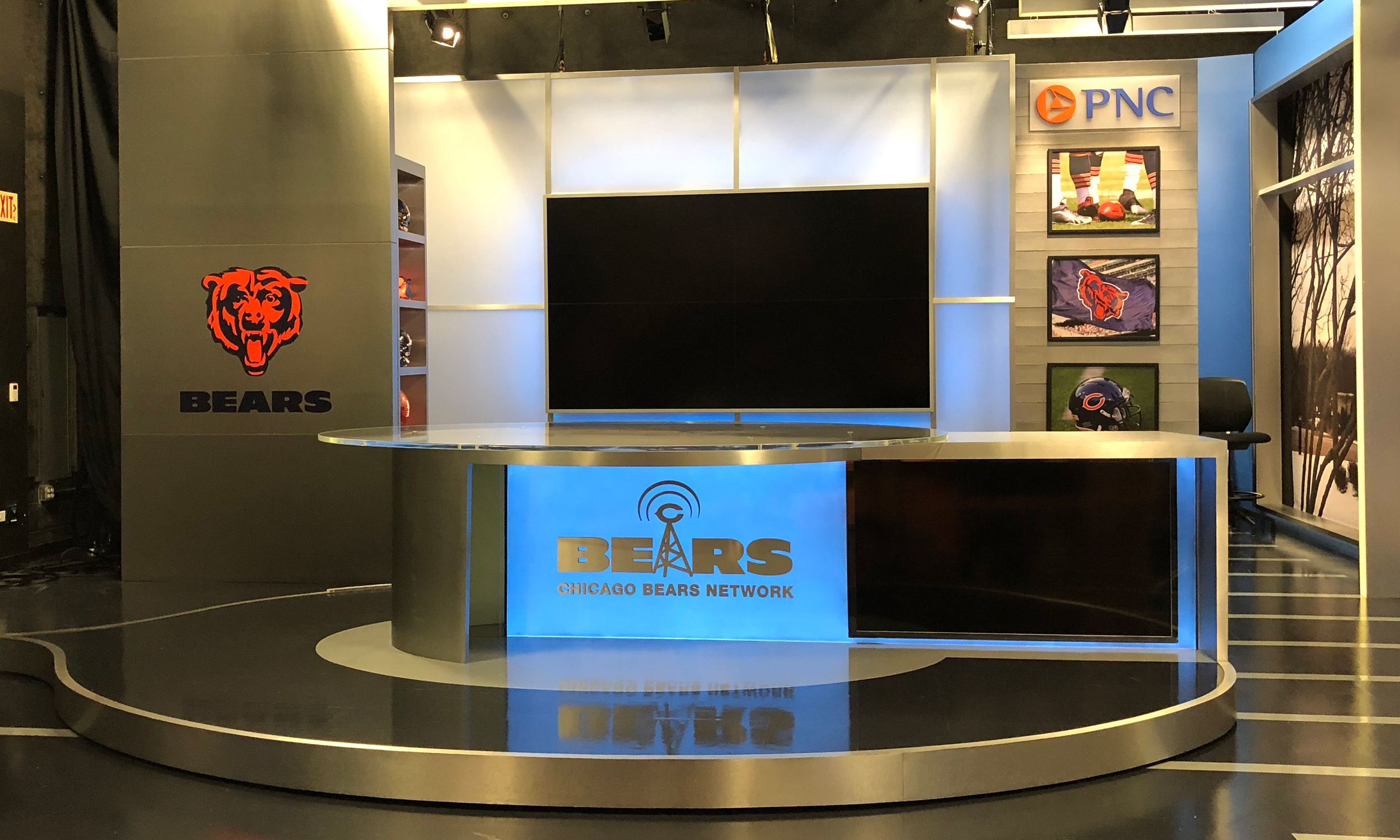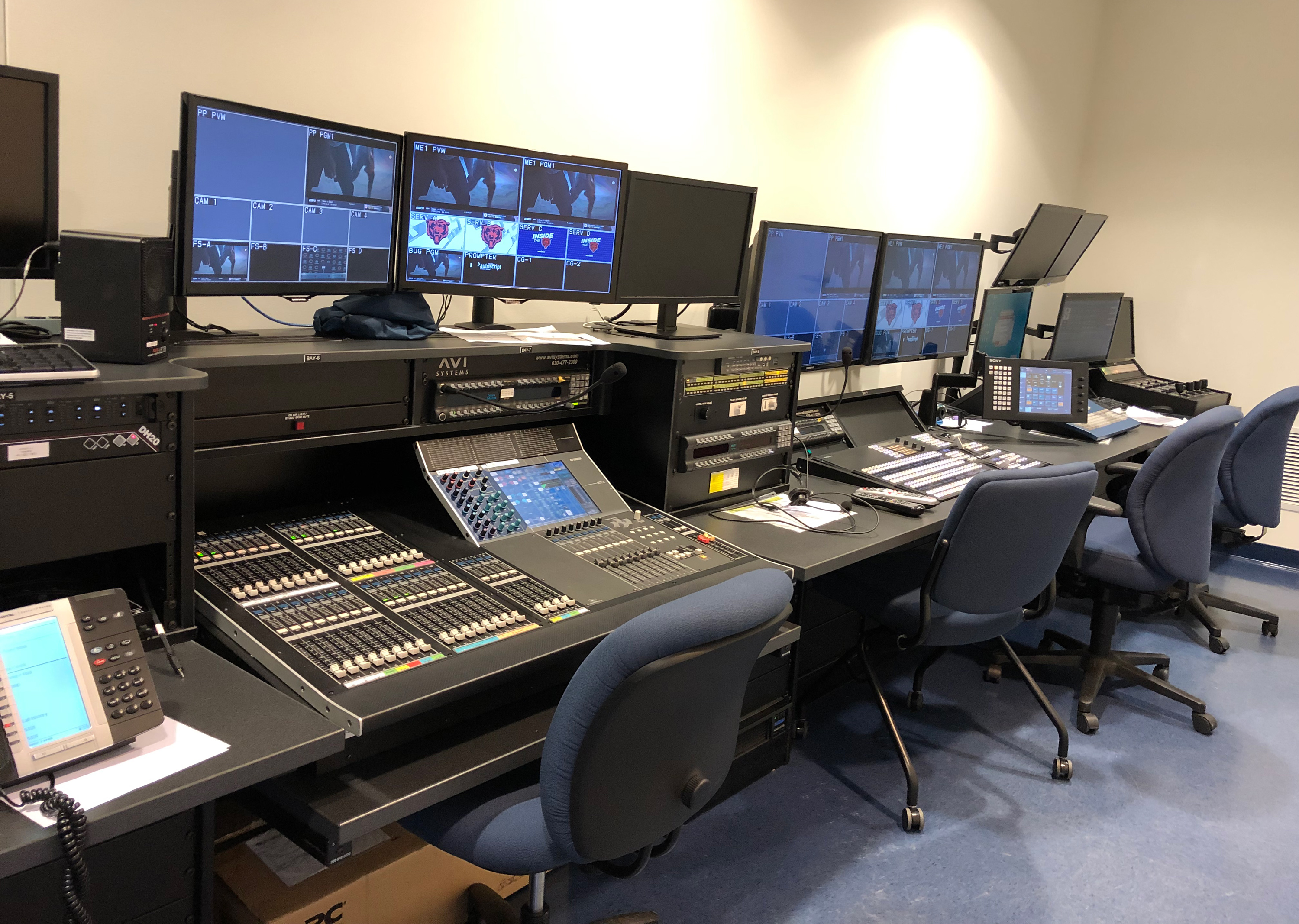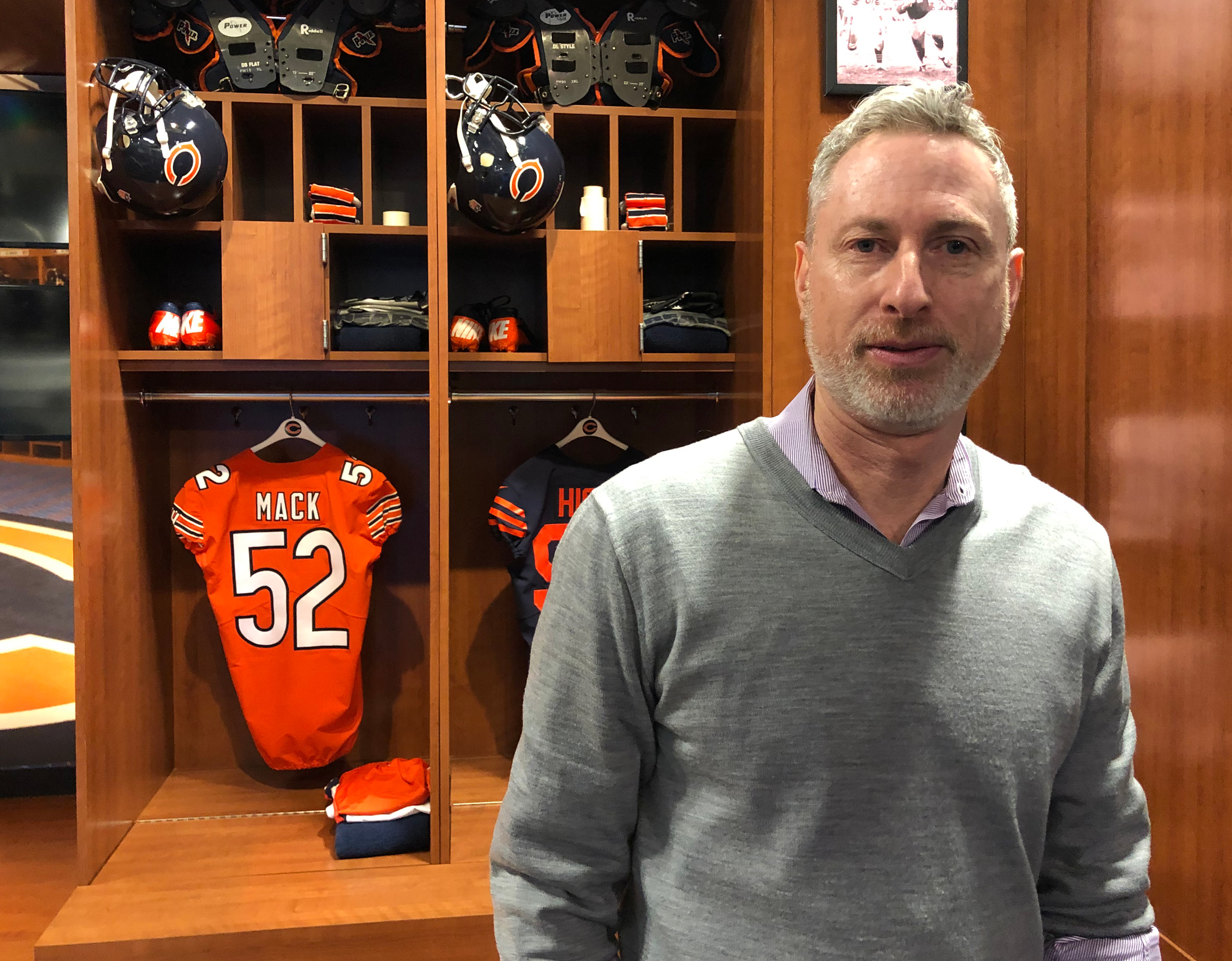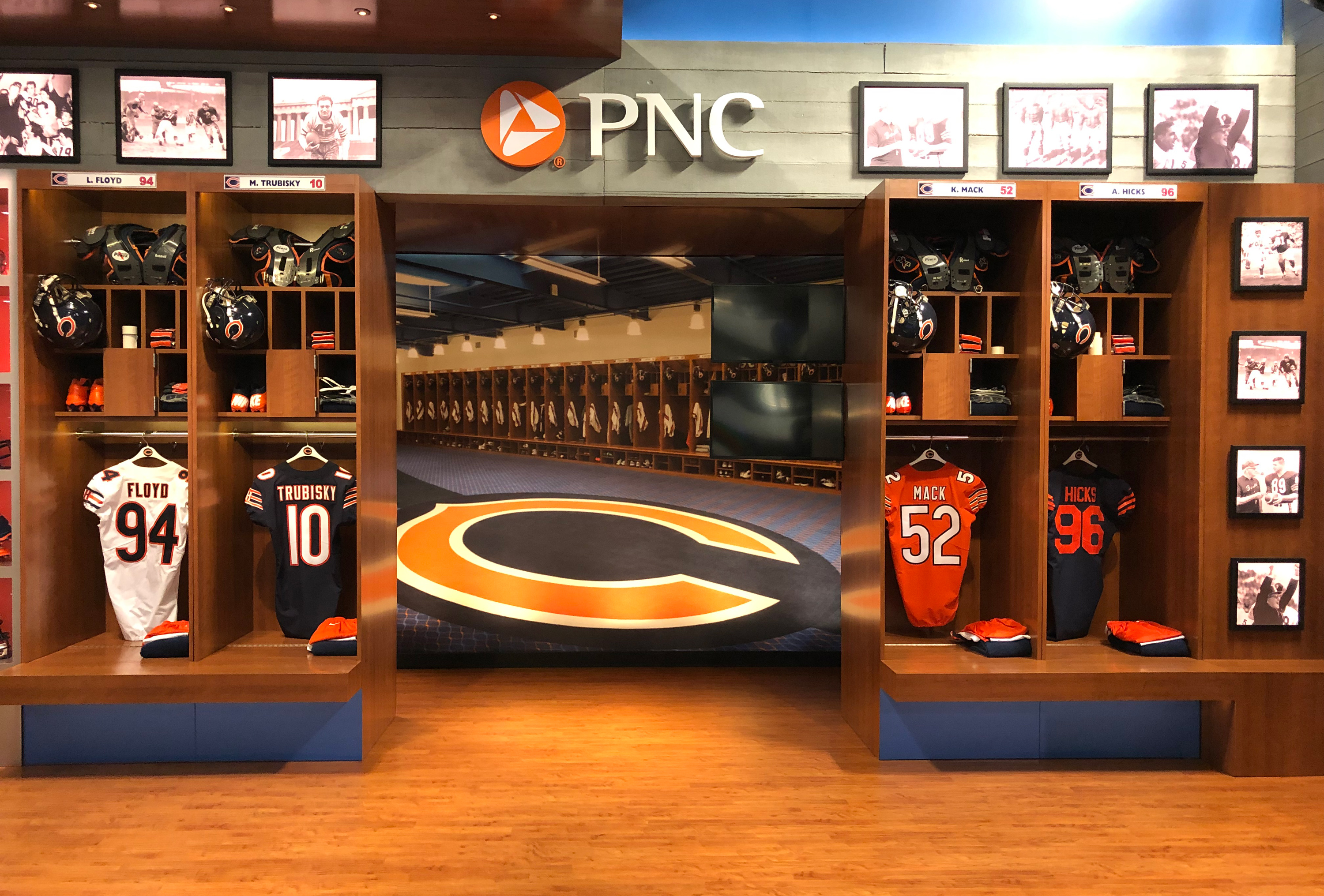Chicago Bears’ Video-Production Facilities at Halas Hall ‘Designed for Versatility’
VP, Content and Innovation, Greg Miller offers a peek inside the team’s resources
Story Highlights
For the Chicago Bears, it all came together. Fast.
First, it was a shocking trade for defensive stud Khalil Mack. Then young quarterback Mitch Trubisky began to mature and excel. Suddenly, after four straight losing seasons, one of the NFL’s most iconic franchises was back, posting a 12-win campaign. And the team’s in-house video-production department was up to the task.

The Chicago Bears’ facilities include a 2,100-sq.-ft. video-production studio built during a renovation of Halas Hall in 2013.
“What stands out [from 2018] was the ability of the staff to be prepared for success,” says Greg Miller, VP, content and innovation, Chicago Bears. “When you go through multiple seasons without much success, it can be easy to hang your heads. You don’t get to do a lot of the cool things, and it’s hard to maximize your content in the way that you want to. But you have to be prepared for when that success does come. I was really proud of everybody, because we were.”
The Bears have been at this video-production game for quite some time. In fact, they’ve been doing it longer than most NFL franchises. Miller has been handling in-house media for the club for more than 15 years, and the team has used a 2,100-sq.-ft. television studio at the team’s headquarters in Halas Hall since 2013.
These days, Miller oversees everything under the umbrella of content and production, digital media, and social media. The team is up to 17 full-timers across all those divisions, which are headed by Dan Barile (director, content and production), Matt Koch (director, digital media), and Jen Tulicki (director, social media).
When it comes to content, Miller takes a rather practical approach. Content that engages audiences and brings value to the team’s corporate partners takes top priority. From there, the devil is in the (data-filled) details.
“Every piece of content is a winner or a loser,” Miller explains. “You want the winners, and we have tools to measure that. You know what is winning and what’s losing. Quality wins. If it’s a compelling piece of content, it’s going to do well. To me, you have to customize every piece of content to where it’s going. You can’t take a video that you put on YouTube and just put it on Instagram. You need to be conscious of the platform and the channel.”
As with any professional or collegiate sports program, wins don’t automatically guarantee great content. Much of access relies on building strong relationships with the coaching staff, players, and other departments within the organization. Miller’s team excelled in that area in 2018. Its relationship with the players and coaching staff showed its worth in a series called Club Dub, when videographers were able to capture a series of dance parties that took place in the locker room following wins. That level of access married with a winning record led to a major increase in engagement in the team’s CrowdTangle reports supplied by the league.
Ain’t no party like a #ClubDub party.#DaBears | #NFCNorthChamps https://t.co/5AWCTOC1qa
— Chicago Bears (@ChicagoBears) December 17, 2018
In addition, the entire video-production department drew praise from fans and the industry for its “Monsters of the Midway” campaign depicting the players as Marvel-esque superheroes. The illustrations appeared in graphics and videos across all Bears’ content throughout the season.
“We went all-in on it,” says Miller when asked to explain the campaign’s success. “Some people will dabble in something like that, but we decided to go all-in. We knew that we were changing our look for last season but also that we were only one year away from a look for our 100th [anniversary] so this was the time to do it. It was a bridge year.”

The Bears’ studio is supported by a control room anchored by a Sony production switcher. The control room will remain unaltered as Halas Hall undergoes some renovations this offseason.
The production team worked with one of the Bears’ former players, Israel Idonije, on the campaign. The former defensive end owns his own company called Athletic Comics.
2019 will definitely have quite a different feel with the franchise celebrating its 100th anniversary. Miller hasn’t disclosed details of what that campaign might look like but does note that it won’t just be a sea of sepia tone.
“We are looking forward as much as we’re looking back with our 100th celebration,” he says. “It’s a new era of Bears Football. It’s going to have a modern look. It’s not going to be all just black-and-white photos.”
The distribution game continues to evolve around the industry, as well. According to Miller, the team is exploring the possibility of adding a connected-TV app for the 2019 season. There’s always something new to account for. In fact, the league allowed NFL teams to have their own YouTube channel only as recently as two years ago. Now, according to Miller, it’s one of the team’s most successful platforms.
The content the league allows the team to post in real time on game days “changes every year,” says Miller. “It used to be so limited in what highlights you can use. The league has loosened things considerably. So, each year, you kind of guess what you’re going to be doing because you’re not sure what’s coming. I think the league did the right thing in allowing teams to use highlights. Now there’s still a lot of restrictions in how you use them and how many you can use, but it’s night and day [compared with] where it was.”
As for the team’s facilities at Halas Hall in Lake Forrest, the crown jewel is the large video-production studio. With multiple sets and shooting positions, Miller says, producers can play with countless possible shooting angles and look for a range of content, including traditional linear television shows (shared with the local Fox affiliate), digital platforms (like the team’s robust mobile app), or social media.
In addition to a large anchor desk and other, smaller sets (all on wheels for flexibility), the Bears are able to make the most of the space, deploying three hard Sony cameras (one on a full pedestal, two on classic tripods) with Fujinon lenses, a slick mini jib that captures sweeping images and adds dimensions to the space, a dynamic lighting system, and a changeable backdrop designed by Chicago Scenic.
The studio is supported by a control room that features a Sony switcher, a Ross Abekas replay system, a ChyronHego graphics engine, a Sony shading station, RTS comms, and a Yamaha audio board. The 64×64 Evertz router can route to virtually anywhere in the entire facility.
“We future-proofed this thing,” says Miller, who has a TV background working at a Fox affiliate in the Chicago area. “We’re still good.”


